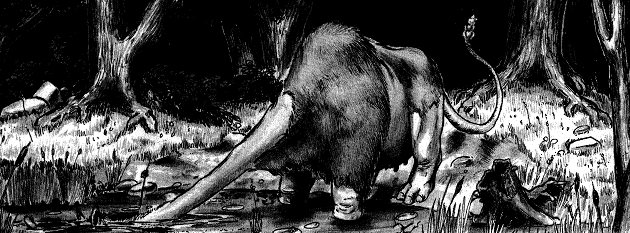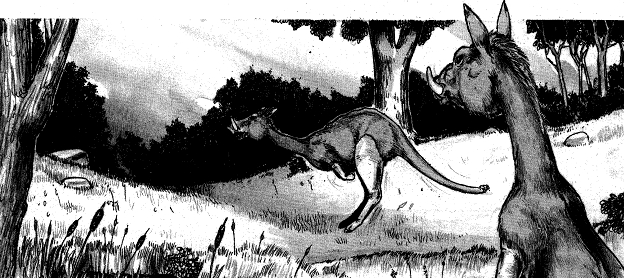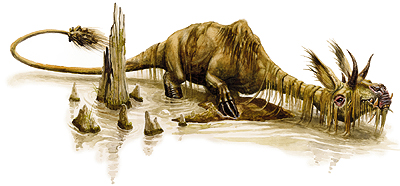



| Dragon | - | Monsters | - | Dragon #73 |
The debate about the nature of the
catoblepas
did not keep the proverbial
man in the street awake at night, but
it
had for generations added fuel (as if
fuel
were needed) to the intense rivalry
between the Wizards' and Naturalists?
Guilds of To-Zen. The problem was one
of demarcation. The naturalists could
not
deny that there were creatures of magic,
and magicians could not help but admit
that nature could at times achieve feats
worthy of any wizard ? but each side
naturally wanted to claim the most
bizarre beast for its own. And when it
came to bizarre, the catoblepas certainly
qualified.
To the wizards, a beast with the body of
a buffalo, a huge tail and neck, the head
of a warthog, and a gaze that slew was
clearly a magical beast, and they bitterly
rejected the jibe of the naturalists that
such a beast, magical or not, would
strangle on its own contradictions. The
beasts had been seen, said the wizards,
which proved that they existed, but any
observer rash enough to meet the gaze
of
a catoblepas died instantly ? and what
more proof did one need of the beast?s
magical origin?
Fair enough, said the naturalists, but
they pointed out that the catoblepas had
been sighted in groups. So, how did they
avoid killing each other ? or themselves,
for that matter ? with their death-ray
gaze? And how, in the name of the
Mnoren, did they breed?
A magical creature, the wizards
patiently explained, wouldn?t need to
breed, would it?
All right, retorted the naturalists, then
how come there are so many of them? Is
some deranged thaumaturgist turning
them out as an occupation?
And so the debate continued, with each
side having enough evidence to support
its unshakable conviction that it was
right, but neither having proof conclusive
enough to convince the other side.
On one particular night, earthshattering
revelations were promised
when the naturalist Bel-Ami, newly
returned from an expedition to study the
creature, was to address a capacity crowd
in the Alchemists? Guild Hall, chosen
as
neutral territory. Inside the ancient
vaulted hall, with its roof blackened
by
the fumes of countless demonstrations
and its air pervaded by the sour reek
of
brimstone, the audience fell into three
very different groups:
On one side of the hall were tight knots
of black-robed apprentices surrounding
splendidly gowned master sorcerers; hardfaced
wizards, many in elaborately chased
leather and silver armor; and a scattering
of commercial-minded wizards and
wizardly priests preserving a dignified
silence. On the other side were the naturalists,
dressed in all shades of brown and
green, accompanied by almost as many
tame hawks, hounds, birds and dragonets.
And all around the upper gallery was
crowded a mob of curious citizens, eagerly
speculating on the outcome of the
evening.
Suddenly, as if on a signal, silence fell
over the hall. Bel-Ami, a stocky, bearded
man in a curiously patterned green robe,
came in from the side entrance leading
an
extraordinary creature. The height of
a
man, it shuffled nervously on its huge
back legs and muscular tail, whilst its
small forepaws twitched agitatedly and
its
delicate head swung this way and that,
eyes, ears and nose straining in all
directions.
?I expect you?re all wondering what
this little fellow is doing here,? said
the
famous naturalist. ?Well, after much
patient and often dangerous observation
in some of the wildest country in To-Zen,
I can reveal that, far from being just
another grazing animal, as we had formerly
thought, this is a male catoblepas!?
This remark immediately prompted a
general uproar in the hall.
?No, please ? please relax! ? no, he?s
perfectly safe, but he does hold the key
to
the mystery. You must all have read the
classic description of, as we call it,
the
?cat? in the Bestiary of Xygag, although
how he worked out that its eyes are
?bloodshot? escapes me, and for a beast
?horrible beyonde alle description? he
goes into a fair amount of detail!
?Well, as far as he goes, he?s right,
but
he didn?t realize that they were only
the
female of the species. From my studies,
I
have established that the female is a
large
omnivore, feeding mostly on ooze and
water plants dredged from the swamps it
lives in, but gaining an important part
of
its diet from animals it has killed. And
no, she doesn?t kill them with her deadly
gaze, but with her breath!
?The female catoblepas secretes a gas,
deadly to anything except the female
catoblepas, that is belched out in an
invisible cloud. The effective range is
only about sixty feet before it disperses,
but within that range, the only chance
of
escape is to run faster than the cloud
expands. The gas is equally deadly if
breathed in or absorbed through the skin.
?It was obvious from the time that I
started to form this hypothesis that the
?cat? was immune to its own poison, but
it was not for a long time afterward that
I
connected the female catoblepas with the
small herds of grazers that were always
found in the same area, following at a
discreet distance, and realized that they
were two forms of the same species!
?The male, poor fellow, is not immune
to the poison cloud, and normally keeps
well clear of the female. But in the mating
season, the female exudes a scent
which drives the male wild with a lust
that frequently overpowers his instinct
for self-preservation. He must try to
wait
until a solitary female is feeding with
her
head buried in the ooze of the swamp.
Then, sprinting up to her, he dodges the
heavy tail normally used as a defense,
mates very quickly, and sprints off again.
?Six months later, the small, deer-like
young are born. Since they are exposed
to
mild doses of the toxin before birth,
they
are immune to it. They are all weaned
together, but at the end of the first
year
something very strange happens. The
young scatter, and differentiate into
sexes
? a minority of females which remain
immune to the toxin that they have
begun to secrete, becoming fatter and
thicker and eating flesh as well as plants;
and the males, which undergo a radical
change in their body chemistry, losing
their immunity to the toxin and becoming
fast-moving herbivores.
"As yet I can only speculate on the reasons
for this division of the species; it
may ensure a fitter breeding stock, or
allow better use of existing food resources
than the more conventional way, or both,
or neither. Anyhow, enough talk. I?m
open to questions from the floor."
During the course of his speech, all the
magicians in the audience had been
growing more and more restless. Now,
one of their number burst from the
audience with a horrified cry.
?You can?t be serious! This must be
your warped naturalist?s idea of a joke!?
?Never more serious, I assure you,?
responded Bel-Ami.
?But, this is awful! When we heard
that you had an astounding revelation
in
store for tonight, we were going to
upstage you. My apprentices have gone
out on an expedition to kill a catoblepas
and bring it back as proof of its magical
nature.?
?That?s quite possible. They can be
killed.?
?I know that, and you know that ?
but how far are they going to get with
a
polished shield?!?
(An earlier version of this article
appeared in Dragonlords -- Yet Another
Fantasy & Sci-Fi Roleplaying Magazine.)

Q: In issue #73, the
catoblepas is noted for being able to kill by its breath;
this contradicts what's
in the Monster Manual.
Which source is correct?
A: The Monster
Manual is the final
authority here. The article
on the catoblepas,
like all the other articles
in "ecology
" series in this magazine,
is an
attempt to work out some
of the monsters
from the AD&D
game system in a logical
fashion with regard to their
habitats,
mentalities, behaviors,
and so forth. This
material is unofficial,
offered for the
entertainment of (and possible
USE by)
DMs and players alike.